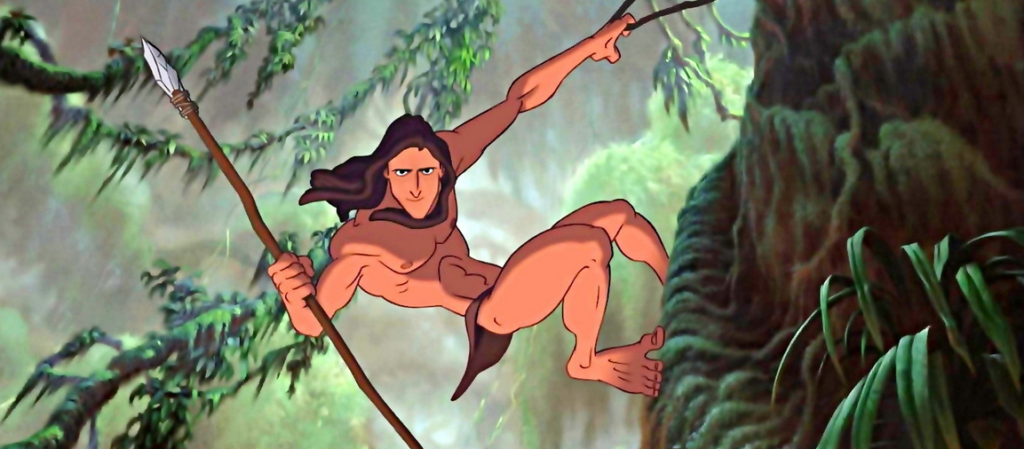
After surviving a fiery shipwreck, a young couple and their infant son head for shore and start fresh in a treetop home. But the dark, dangerous side of this jungle paradise quickly rears its head. The baby is orphaned by a bloodthirsty leopard, then adopted by Kala, a maternal gorilla who recently lost her own baby to the same carnivorous beast. The dominant male in her group, a silverback named Kerchak, doesn’t warm up to this hairless creature, and Tarzan spends years trying to prove himself worthy of Kerchak’s trust (other animals must also overcome prejudices and eventually embrace Tarzan as a true friend). One day, a trio of humans arrives on expedition. Jane Porter and her father want to observe gorillas in their natural habitat. Their guide, an oily opportunist named Clayton, has other plans for the simians. British propriety meets primitive knuckle-dragging when Tarzan rescues Jane from marauding baboons. He proceeds to spend time with Jane and in the tourists’ camp, learning about his people and the world beyond his jungle home. Love blossoms. Will Tarzan go with Jane? Will Jane stay with Tarzan? Will the gun-waving Clayton ruin everything?
Positive Elements: Many demonstrations of loyalty, heroism and selflessness. Kala risks being ostracized by her primate family to raise Tarzan as her own, accepting and encouraging him despite Kerchak’s objections. Tarzan comes to the aid of both Jane and Kerchak when their lives are in danger. Tantor musters courage upon hearing that his life-long friend is in trouble. As a boy, the rambunctious Tarzan nobly accepts responsibility for causing an elephant stampede. As an adult, he demonstrates an unquenchable thirst for knowledge. When Tarzan contemplates leaving for England, he tells a supportive, but saddened Kala, “No matter where I go, you will always be my mother.” Kerchak apologizes to Tarzan for not understanding, and calls him his “son.” The film esteems kindness and civility while condemning barbarism. It elevates the concept of “family” as paramount, and presents warm, positive parent/child relationships.
Sexual Content: None, though a curious Tarzan innocently lifts the hem of Jane’s dress and puts an ear to her breast (to hear her heartbeat). Also, a buffed Tarzan spends most of the film dressed only in a loincloth.
Violent Content: Young children may be frightened by a series of vicious animal attacks. The death of Tarzan’s parents is handled discreetly, though their inert bodies can be seen briefly lying in the shadows. Hunters carry guns, most notably Clayton who fires in Tarzan’s direction several times and even kills a gorilla. Pirates take prisoners by force. Clayton meets a violent end, a victim of his own bloodlust (he’s tangled in and ultimately strangled by vines).
Crude or Profane Language: Minor. Parents of preschoolers may object to an elephant shouting, “My butt!,” and making a subtle remark about flatulence. Porter exclaims, “Good lord!”
Drug and Alcohol Content: Clayton pours wine for himself and Tarzan (who puts his glass down without drinking from it).
Other Negative Elements: Struggling to overcome his “outsider” status, a young Tarzan eagerly accepts a dangerous challenge in an attempt to be included by his gorilla playmates. Fortunately, consequences arise, allowing parents to teach children that foolhardy behavior inspired by peer pressure can lead to trouble.
Summary: It’s easy to walk into Tarzan somewhat skeptical. After all, Disney has done the “jungle” thing twice before (Lion King and Jungle Book) and it’s not unreasonable to ask, “What will they show me that hasn’t already been done?” If that thought has crossed your mind, prepare to be pleasantly surprised. Disney’s third foray into the wilds of Africa uses fresh animation techniques to make this jungle among the most lush and exhilarating backdrops ever used for a feature-length cartoon. Rolling waves and rippling lakes. Rustling trees and cascading waterfalls. The dimension and texture of this wilderness might make viewers forget that it’s artificial.
The musical score (courtesy of Phil Collins) is understatedly appropriate for swinging this tale from one vine to the next. But don’t expect to leave the theater humming a high-profile production number like Lion King‘s “Hakuna Matata,” The Little Mermaid‘s “Under the Sea” or Aladdin’s “Friend Like Me.” Tarzan‘s songs help tell the story without drawing undue attention to themselves–definitely a plus here. One of the film’s cutest numbers involves monkeys making music purely as a byproduct of trashing the humans’ camp (this scene also includes a clever homage to Beauty and the Beast).
Unlike previous Hollywood versions of Edgar Rice Burroughs’ classic Tarzan story (this film is number 48), Disney’s animated retelling explores a dimension the others could only allude to: interspecies communication. Talking gorillas provide a new level of relationship between Tarzan and his extended family. A warmth. A depth. It makes the story seem fresh, no matter how many times we may have heard or seen it before. Toss in likable characters, healthy morals and scenery any actor would gladly chew (which Rosie O’Donnell does as a punk ape) and it’s clear that Tarzan will charm viewers of all ages.
